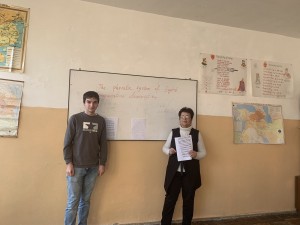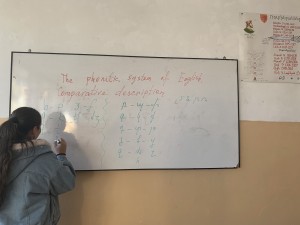Another joint lesson depicts the comparative study and description of phonetic systems of English and Armenian. The lesson aims at making the students go into other spheres of the language that influence the learning process. The pragmatic target is to teach the pupils to make use of the dictionaries in terms of pronunciation.
Pronunciation is more than ‘listen and repeat’. Pronunciation includes features of language (vocabulary and grammar) and skills (speaking and listening). Like vocabulary and grammar, we pronounce by noticing and understanding rules and patterns which lie beneath the surface of speech. Thus, the students go deeper into the field of Phonetics. Phonetics is an essential part of a language, because it gives a language a definite form: the vocabulary and grammar of a language can function only when the language has its phonetic form.
The students are able to analyze the production of speech that looks at the interaction of different vocal organs, for example the lips, tongue and teeth, to produce particular sounds. By classification of speech, they focus on the sorting of speech sounds into categories which can be seen in both languages.
Co-teaching method is justified, as it is a norm to make comparative analyses in the Language classroom.
Grade 11-3
Teachers: A. Azizyan S. Brutyan
4.11.2019

Լրահոս
- «… Ձեզ եմ ասում, ձեզ, հայոց նորահաս երիտասարդք, ձեր անումին մեռնիմ, ձեր արևին ղուրբան, տասը լեզու սովորեցեք, ձեր լեզուն, ձեր հավատը ղայիմ բռնեցեք»։
- Handwriting Day, January 2024
- WSP Project Announcement
- Կրթության միջազգային օրվան ընդառաջ,այց մեծ լուսավորիչ Խաչատուր Աբովյանի տուն_թանգարան
- Հայրենասերը իր երկրի շենացողն է ու բարերարը,երկրի հոգսերով ապրողն ու ապրումակցողը։
- Պատմության հետքերով
- Ուսուցման գործընթացում կարևոր է առարկաների,գիտությունների համագործակցությունը.այն օգնում է բացահայտելու ուսուցանվող առարկաների ու երևույթների միջև եղած կապերը,պատճառները,փոխկապակցվածությունը։
- Ways to Improve Your Creative Writing Skill
- Այսօրվա մեր այցելությունը թանգարաններ արտասովոր էր։ Միաժամանակ այցելել մեր ժողովրդի անվերապահ պաշտամունքին արժանացած երկու հսկաներին, որոնք ժամանակակիցներ էին, ինչ-որ տեղ ուրիշ ախարհներից սնունդ առած ու ինչ-որ առումով նաև հակառակորդներ։ Փարաջանովը այն իշխանության զոհն էր, որին ծառայում էր Դեմիրճյանը։ Բայց տպավորությունը, որ ստացանք (11-1, 11-3դասարաններ), նրանց թանգարաններ այցելելուց, միանշանակ ափիբերան հիացմունքն է ու արդարացված պատկառանքը նրանց ու նրանց գործի նկատմամբ։ Արվեստի անսովոր ուժը և հասարակական գործչի օրինակելի կերպարի փոխանցումները իրար լրացնող լարեր են, որոնք քաշելիս երկնքից մի ձայն ասում է` գոնե մի պահ խենթացիր, մա՛րդ։
- Հունվարի 11-ը նշվում է որպես Շնորհակալության միջազգային օր։
- Ավարտական քննությունների մեկնարկ
- Այսօր Վահան Տերյանի հիշատակի օրն է։
- Սիրելի աշակերտներ,
- Маяковский сегодня.
- 139-ի շնորհալիները շարքից
- Formative Assessment Test Ideas
- Սերունդների համերաշխություն.սերնդափոխություն։
- Դեկտեմբերի 15-ը ՝ Թեյի միջազգային օր
- Whole School Project “NORMS VS ANOMALIES”
- ԽԱՂԱԼԻՔՆԵՐԻ ՀԵՂԻՆԱԿՆԵՐՆ
- Կախվածությունների բուժման ազգային կենտրոն
- Մանկավարժական մտքի փառատոն`աննախադեպ մտքերի ու գաղափարների հեքիաթային աշխարհ։
- Путешествие по Санкт- Петербургу.
- Դեկտեմբերի 8-ը Նկարչի միջազգային օր
- Interact with Biology
- ՀՀ կրթության,գիտության,մշակույթի և սպորտի նախարարության աջակցությամբ ու Հայաստանի պետական սիմֆոնիկ նվագախմբի նախաձեռնությամբ 2018թ. իրականացվում է «ԴասA» կրթական ծրագիրը։
- Scaffolding in Teaching
- Թարգմանչաց տոնի առթիվ X-6 տնտեսագիտական հոսքում համատեղ դասավանդում իրականացրին ուսուցիչներ Օ. Ղարիբյանը(Հայ գրականություն), Ա. Միրզոյանը ( Անգլերեն) և Ա. Խլղաթյանը ( Հայոց պատմություն)։
- Project -Based Learning Ideas in High School
- Դեկտեմբերի 1-ը ՁԻԱՀ-ի դեմ պայքարի համաշխարհային օրն է
- The Book of the Month
- Մանկավարժական ոլորտում փորձի փոխանակման միջոցառումների շնորհիվ անընդհատ կատարելագործվում է ուսուցչի նորարարական մոտեցումների կիրառումը ,ու լավագույն փորձը արագ տարածվում է։
- “Education is the passport to the future…”
- Բոլոր ժամանակներում ուսումնական բոլոր գործընթացներում կարևորվել են միջառարկայական կապերը, իսկ հանրակրթության նոր չափորոշիչներում դրանք արդեն պարտադիր պայման են
- Media Education in High School
- Youth engaged in Projects.
- Բարության օրը մի կաթիլ բարությամբ
- Создание армянских и славянских письмен.
- Երևանի Վալերի Բրյուսովի անվան օտար լեզուների համալսարանի ներկայացուցիչները դարձյալ դպրոցի հյուրերն էին
- Majoring in History
- Մշակութային ժառանությանը ծանոթանալը ժամանակի հրամայականն է ու Երևանի Կարեն Դեմիրճյանի անվան հ 139 ավագ դպրոցի պարտադիր պահանջներից մեկը.կրթօջախը ջանասիրաբար իրականացնում է այցեր թանգարաններ,պատկերասրահներ,գրադարաններ,թատրոններ։Դրանք չափազանց կարևոր են թե ազգային ինքնաճանաչողականության,թե մշակութային բազմազան միջավայրում ճանաչելիության առումով։
- Վարպետաց դաս 139-ում
- Pride as norm and vain glory as anomaly
- «Աշխարհացույց» կրթական հարթակը Երևանի Կ.Դեմիրճյանի 139 ավագ դպրոցում
- Երևանի հ 139-ի շրջանավարտներին
- My Home is my Castle.
- Отговорила роща золотая…
- Interdisciplinary learning.
- Երևանի Կարեն Դեմիրճյանի անվան հ 139 ավագ դպրոցում ծնողական խորհրդի ներգրավվածությունը միշտ էլ արժևորվել է.ծնողներին համատեղ գործունեության մեջ ներգրավելու փորձը ցույց է տվել,որ նույն կրթական միջավայրում փոխգործակցելով ՝ ավելի արդյունավետ է լուծվում սովորողների կրթման և սոցիալականացման խնդիրները։
- Вызовы и перспективы
- Համագործակցության ծիլեր
- Teenage problems and solutions
- Ярмарка проектов
- Դպրոցը կարդում է ու նկարում
- Երևանի Կարեն Դեմիրճյանի անվան հ 139 ավագ դպրոցի ֆիզմաթ հոսքի սաները Երևանի աստղացուցարանում՝ դիտելու տիեզերքի ծագումը,մոլորակների կազմավորումը,տիեզերագնացության զարգացումը։
- Understanding and responding to teenagers’ needs
- Norms VS Anomalies (WSP)
- Ամփոփիչ դաս՝ ուրարտագետի դիտարկումներով
- Международный день переводчика
- Կրթական Օսկարի հաղթողը
- Երևանի Կարեն Դեմիրճյանի անվան հ 139 ավագ դպրոցի
- Interact with History
- Մտքի փորձառությունն է օգնում դուրս գալ ծանր վիճակից ու դիմակայել ժողովրդին սպառնացող մարտահրավերներին։
- Սիրելի՜ նորնորքցիներ
- Նոր ուստարին նոր շենքում
- Ստեղծագործելով կորցնում ես սխալվելու վախը
- Հայրենիք,պատիվ,նվիրում.յուրաքանչյուր դեմիրճյանականի նշանաբանը
- Ավարտը՝ մեկնարկով
- Այս ժպիտի ու այս հմայքի մշտակայության մաղթանքներով….
- Բարի երթ ձեզ,սիրելի՜ շրջանավարտներ
- New Standards for General Education
- Армяно-российские отношения
- «ԲանՈւԳործ.ԵՊՀ էքսպո-2023»
- Գիտելիքով նվաճված հաղթանակ
- УРОК- КОНКУРС
- Բաց դռներ
- Խոնարհված ծաղիկներին նոր կյանք
- Մայրաքաղաքում ապրիլի 29-ը հայտարարվեց համաքաղաքային շաբաթօրյակ
- Նոր մեթոդներ , նոր մոտեցումներ՝ ձևափոխվող կրթության պահանջներին համահունչ։ 10-3/պատմական հոսք/ դասարանում կայացավ ամփոփիչ դաս՝,,Վահանանց պատերազմ,, թեմայով։
ՏՀՏ գործիքներից կիրառվեց ին Padlet, Power point,SmartArt ծրագրերը
Դասը անցկացվեց բացառապես գծապատկերների տեսքով,ապա անցկացվեց ,,Դերային խաղ,,, երբ պատմական կերպարները աշակերտների ներկայացմամբ
փորձում են լուծում տալ առաջ քաշված հիմնախնդրին,, Պայքար հայոց ինքնության պահպանման համար,,։
Խաչվող հասկացություններ՝պատճառ և առիթ, անհատ և հասարակություն, պատճառ և հետևանք։
ՀԳ Շնորհակալություն աշակերտներին՝ բարձր պատասխանատվություն դրսևորելու համար։
Ուսուցիչ՝ Կ․Գրիգորյան - Лермонтов «Мцыри»
В современном темпе жизни система образования претерпевает изменения. Внедряются новые методики и подходы к обучению, открываются информационно-образовательные пространства, которые позволяют развивать цифровую грамотность школьников, их творческую и проектную деятельность, а также их познавательную и социальную активность. Поэтому учителю тоже стоит обратить на это внимание при подготовке к урокам.
Проведение флешмоба решает большой спектр задач. Среди них:
• приобщение детей к книжной культуре, а также воспитание грамотного читателя;
• повышение эффективности работы по приобщению детей к книгам во взаимодействии всех участников образовательного процесса;
• обогащение словарного запаса детей,развитие грамматического строя речи;
• совершенствование коммуникативных навыков, активизация творческого потенциала у школьников;
• развитие формы воображения, в основе которой лежит интерпретация литературного образа.
На сей раз внимание учеников привлек главный герой поэмы Лермонтова «Мцыри». Чтобы лучше понять этот образ школьники в первую очередь обратились к истории создания произведения, которая могла бы сама по себе стать сюжетом для повести. Замысел написать поэму о юном монахе, погибающем в неволе монастыря, появляется у поэта еще в юности. В дневнике семнадцатилетнего Лермонтова мы находим следующие строки: «Написать записки молодого монаха 17-ти лет. С детства он в монастыре, кроме священных книг, ничего не читал. Страстная дума таится – Идеалы». Но понадобилось достаточно много времени, почти 10 лет, чтобы замысел поэта воплотился. Самым сложным оказалось найти те идеалы, за которые мог бы погибнуть герой.
Соединив услышанное от монаха со своими более ранними набросками, поэт создает окончательный вариант поэмы. Интересно, что он практически не изменил рассказ монаха, за исключением одной ключевой детали. Герой «Мцыри» не может смириться с монастырем, что является для поэта наиболее важным. Так рождается романтическое произведение «Мцыри».
Разумеется, какая бы история не лежала на самом деле в основании поэмы, потребовался огромный поэтический талант, чтобы превратить ее из простого рассказа о военных событиях в гениальную поэму. Создание «Мцыри» Лермонтова потребовало от него многих лет вдохновенного труда, а результат восхищает читателей и поныне. И это восхищение привело наших учащихся к мысли о флешмобе, дабы разделить свой восторг со слушателями.
10/1 класс
Учитель Егиазарян К.А. - Հաղթողի պատվանդանին
- Նոր համագործակցություն ու նոր հեռանկարներ
- Exam Mode Activated
- Երաժշտությունը ձևավորում է բնավորություն ու կամք,տարածական մտածողություն ու կարգապահություն,համբերություն ու հաղորդակցություն.ինչու՞ չմեկտեղել այս ամենը ու միաժամանակ չճաշակել բարձրաճաշակ երաժշտություն։
Երևանի Կարեն Դեմիրճյանի անվան հ 139 ավագ դպրոցի սաների ուսուցումը բազմակողմանի է ու կենդանի։ - Տիեզերքի թանգարանում
- Տիեզերագնացության օր
- Շնորհավոր ապրիլի 7
- Языковая политика и вопросы гуманитарного образования
- Where Time Begins
- Գիտության փառատոնի մշտական և փառավոր ներկայացուցիչ՝ Կ.Դեմիրճյանի անվան հ 139 ավագ դպրոց
- Հոգեբանի և ուսուցչի օգնականի աշխատանքային
- Interdisciplinary Project Ideas
- The Majesty and Grandeur of the English Language
- Ռազմահայրենասիրական դաստիարակությունը սկսվում է դպրոցից
- Dedicated to Women’s Day-The Galatea Effect
- Destination- Armenia
- Բաղադրյալ բառերը սև, սպիտակ, կապույտ, նարինջ, կանաչ, դեղին, կարմիր-(ն)երի խմբերում
- Teaching Logic and Sequencing through Narrative


